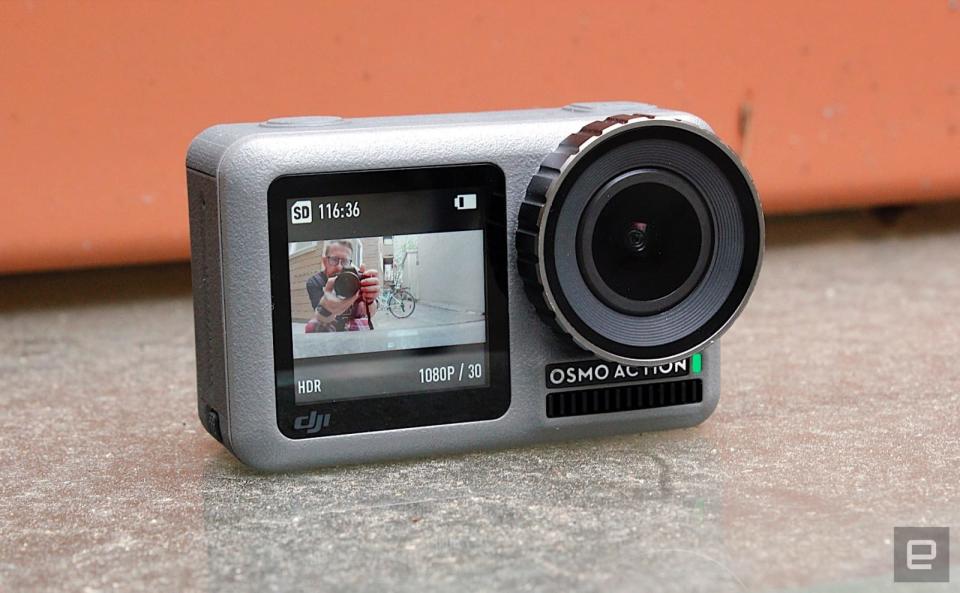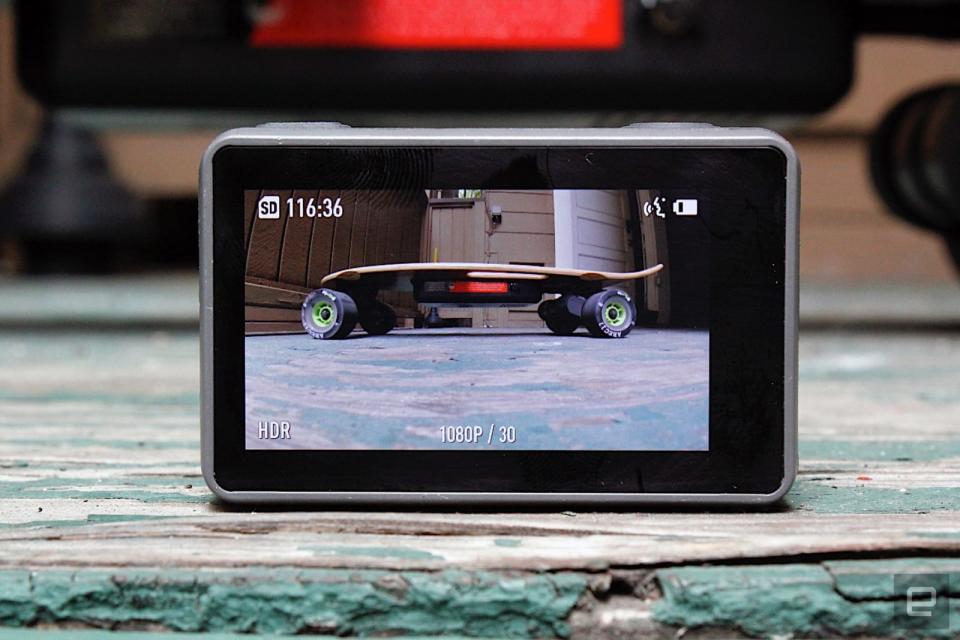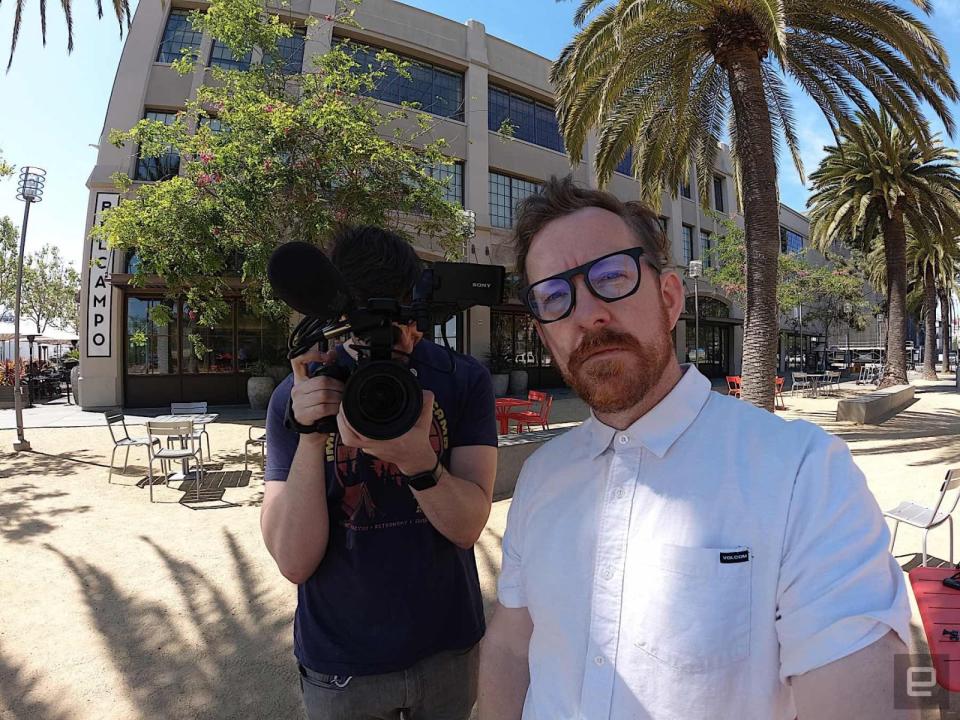DJI Osmo Action review: A worthy GoPro rival
The drone-maker fights back.
Well, here's a surprise. After GoPro trod on DJI's foot with its ill-fated Karma drone, DJI is stomping right back with a rugged camera of its own -- the Osmo Action. It looks like a GoPro, is similarly priced ($349 -- $51 cheaper) and pretty much goes toe-to-toe with the Hero 7 Black on key specs. Can DJI pull off what GoPro couldn't, and give its rival a run for the money? We'll get to that, but at the very least, the king of action cams has a new challenger to fend off, and that can only be a good thing for video-loving action fans. Let's be clear: This might be DJI's first foray into this exact space, but the company has been making cameras since at least the Phantom 2 Vision in 2013. Most of its drones come with one built in, and the Osmo series of handhelds has been quietly growing in popularity for a few years. The Osmo Action is an extension of that line for the extreme sports crowd. Theoretically, you now have a DJI camera for the air, land and everything in between. Before we get into the nitty-gritty, how does the Action stack up against the GoPro Hero 7 Black in terms of flagship features? Both shoot up to 4K at 60 frames per second, snap 12-megapixel photos, come with electronic stabilization, offer up to 8X slow motion and are waterproof (GoPro to 33 feet; DJI to 36). It's within those features where you'll find the key differences, and we'll tell you why they matter. But at a high level, these two cameras offer roughly the same specifications. As already mentioned, the Action looks a lot like a GoPro. It's roughly the same shape and size. (The Osmo is wider, but not quite as tall.) This is not a coincidence, of course. Not only does the design let you know this is an action camera, but it also means the Osmo will be familiar to the very GoPro customers DJI clearly wants to lure over. It also means there will be a good slice of GoPro's accessory catalog (including some you already own) that will be compatible, provided they have GoPro's proprietary three-pronged connector. The main physical difference, and clearly DJI's unique selling point, is an LED display on the front. It's a simple solution to a simple problem: framing yourself in shot. With a GoPro, it's trial and error. (Hint: Point the lens at your stomach when the camera is on a selfie stick.) But even that can go wrong, so having a screen showing your shot in real time makes sense. That said, the 1.4-inch second display is small enough that beyond arm's length it's hard to make out what it's showing. This secondary display isn't a touchscreen either, so you'll need to flip the camera around or reach for the buttons to change any settings. Curiously, the two displays are linked. As in, only one screen can be active at a time, and the standby time for the main display determines how long the small one remains active. To wake the front screen (once it goes to sleep), you have to touch the rear one. It's a counterintuitive setup that it limits the smaller display's practicality, but it's theoretically fixable in software, so we can always hope for an update. Unlike a GoPro, there's no HDMI port on the Active. If you like to connect your camera to a TV or monitor to view your footage, you're out of luck. Like the GoPro, you will be able to connect external microphones via the USB-C port, and DJI informs me an official accessory will be available. There are three buttons on the Action: one for the shutter (start/stop recording), one for power, and a "quick set" button on the side for switching between modes (photo, video and so on). The battery door is actually part of the battery (the whole thing pops out), and the cell inside is 1,300mAh, slightly larger than GoPro's 1,220mAh capacity. (It offers about two hours constant FHD recording to GoPro's hour and a half-ish.) The attached door is curious, as it doesn't seem to provide any benefit, and occasionally I spotted it hadn't "clicked" into place properly, which makes me nervous about it keeping a waterproof seal. Thanks to the Action's extra width, the LCD on the back has a 16:9 aspect ratio. It feels more spacious than what you'll find on the GoPro, but the real perk here is that videos and the viewfinder fill up the whole screen -- no letterbox effect like on the Hero 7. This is only true when playing back something that was recorded in 16:9, of course, but it's a nice touch nonetheless. With their small displays, action cameras always have an awkward menu system, especially if you're operating it with gloves or wet fingers. DJI hasn't done anything too different here. Most of the menus are accessible by swiping in from each edge, a maneuver GoPro users will already know well. One weird thing I noticed is that there's a big delay between the lens and the display when stabilization is switched on. It's less than one second, but it's noticeable. With a GoPro and the Action side by side, if I move my hand in front of both cameras, the GoPro will show it in near real time; the DJI takes way longer. Like, the whole movement will be completed on the GoPro before the Action even registers. DJI tells me it's aware of the issue and that it has to do with the processing needed for stabilization. (My tests had stabilization active for both cameras.) It's more of an annoyance than anything, but if you're relying on the viewfinder to follow an activity, you're really going to notice it. On a more positive note, there's an option to choose which modes show up when you click the "quick set" button. If you don't care about hyperlapse, for example, you can remove it from the list. You'll still be able to get to it via the touchscreen, but you won't have to click past it when using the physical button. Like the GoPro, the Action has voice control, so you can set it to record with a command. There's no wake word here; simply say "start recording" and it'll begin. I found it responsive, perhaps more so than its rival. But that lack of wake word and high sensitivity also meant I had a few false triggers, where it would start or stop recording because I said something similar to the command. There are also fewer commands in total -- just five -- but they cover the main controls. GoPro currently lists 15 commands and won't suffer from false starts, so it ultimately comes down to whether you prefer convenience over flexibility. Okay, buckle up, because this is where things are going to get a little dense, but it's also probably the most important section for advanced users. Both cameras offer a wide range of video modes and frame rates. For the most part they overlap, but there are some vital differences worth knowing. Let's start with what they have in common. Both top out at 4K at 60FPS, with 30 and 24FPS also available. You'll also find the 60/30/24FPS options in common at most resolutions, although GoPro goes up to 120FPS at 2.7K. For photos, there are the usual timelapse and hyperlapse modes. Beyond this, things start to drift. Notably, the Action has fewer of the "exotic" resolutions that GoPro has supported for years. If you're a fan of the 1440p, 960p or SuperView, know that you still do have 4:3 options on the Osmo (at 4K and 2.7K), but that's it. So GoPro definitely offers more flexibility here -- especially if POV video is your thing. Conversely, DJI's camera has more frame-rate options across the board. DJI includes 50, 48 and 25 at most resolutions. Things get even busier at FHD, where you'll find 240, 200, 120 and 100 FPS in the mix. Those are specialty settings, but they match what you'll find on a Mavic drone. Presumably, the idea is that you can use the Action on the same project as a Mavic and match up the FPS for consistency. That said, it's possible to wrangle a video into a different frame rate after the fact, but if you wanted to shoot at a certain aspect ratio/resolution, you ideally want to do it at source. Another trick the Action has that the GoPro currently doesn't is HDR video. GoPro does do some image analysis as you shoot (thanks to that custom GP1 chip), but it's not HDR as we know it. DJI offers HDR as a top-level menu option, but the trade-off is you can't use stabilization at the same time. While it's nice that it's here, I struggled to spot major differences between HDR and regular video. In both well lit environments or high-contrast situations, I wasn't sure which clip was HDR mode when I played them back on my laptop (sometimes I had to record myself saying which was which). In the slider below, though, you can definitely see that the HDR image (left) is more balanced where as the non-HDR frame is a little over exposed, even if it's not dramatically different. Weirdly, HDR mode isn't there for photos (something a GoPro can do). Instead, there's an AEB (Auto Exposure Bracketing) mode, which is conceptually similar, but also crucially different. AEB takes multiple photos at different exposures as a burst. They're not compiled into one high dynamic range image by the camera; you just have four differently exposed photos on your memory card. At this point it makes sense to mention color and sharpness. Both cameras perform admirably. With default settings/auto exposure, the Hero 7 Black delivers a slightly more saturated image. The Action is a little more muted, but arguably more natural. Thankfully, thet two cameras have near-identical options for exposure, color, white balance and so on, so you can steer the camera to record flatter (or more saturated!) images depending on your preference. As for sharpness, it's once again nitpicking time. When tapping through videos frame by frame, I found the Hero 7 Black is generally sharper where it matters (the subject, not the background), but this will vary depending on lighting conditions, user settings and whether you have stabilization enabled. All of which is to say, out of the box the two cameras offer subtle differences in color and image quality. For casual users, the Hero 7 Black's livelier colors might be more instantly pleasing for Instagram et cetera, but given that both have manual exposure controls, pro users will be able to dial in the settings to their liking. If slow motion is your thing, the Action matches the GoPro. Anything above FHD, and you're limited to 60FPS. At FHD, both cameras offer 8X slow down (aka 240 FPS). DJI's camera has those 200/100 FPS settings too, but as they're not a multiplier of the standard 30, their use case is a little different. For nearly all of these modes, you won't get stabilization (slow motion is more stable by its very nature), but GoPro's Hero 7 Black does offer "standard" stabilization at FHD/120FPS if you're looking for a smoother option. Until fairly recently, shaky action camera footage was just a fact of life. In 2019, we're finally seeing the end of it. GoPro made a big hoopla about "HyperSmooth" when it revealed the Hero 7 Black, and for good reason: It was a truly impressive implementation of electronic image stabilization in an action camera. DJI followed suit with a similar feature it's calling... RockSteady. (Not sure why we can't just call it "stabilization" but whatever.) In any case, RockSteady works really well. After recording several side-by-side comparisons, I can't decide which I prefer. It's worth noting that DJI's version carries a similar crop to the image at 4K like GoPro does. I'd lean toward the Action for handheld walking shots; it's a shade smoother, but the difference is subtle. The GoPro is more natural overall -- DJI's is more "floaty" which looks good, but isn't always what you want in an action shot. Ultimately your choice of activity will be a deciding factor. If you own a DJI drone, you'll know that there's little to no "fisheye" effect. Nothing ruins a beautiful horizon faster than it looking like an arch. While fisheye has no place in the sky, down here on the ground it's a necessary evil if you want that wide field of view. GoPro started offering "Linear" mode since the Hero 5 to remove it. DJI calls its version of this feature "Dewarp" and it works almost entirely the same way. In both cameras you'll have to accept some cropping, but in return you'll get fisheye-free video. When I reviewed the Hero 7 Black, it was clear to me that GoPro wanted to muscle in on the social crowd. That meant instant options for short video clips, a vertical video mode (ugh) and plenty of easy ways to share your clips, including livestreaming. This is one area that's definitely lacking on the Action. The vertical video mode is not really a "mode," but the Action will recognize that you want to shoot at 90 degrees. But there's no on-screen button for a predefined short clip (15 to 30 seconds, et cetera) and the options in the app for sharing directly to your network of choice require you to export clips as a video first (for photos you're basically using your phone's sharing tool). Perhaps the bigger omission is livestreaming. DJI has the capability, and it's something you can do with its drones, but not with the Action -- at least not for now. On a similar note, there's no GPS sensor either. This has been a feature that's been included on GoPro cameras for a few years now, and it's vital for DJI drones, so I'm surprised it's missing here. Many of you might not think you need it: You know where a video was shot, but it has other uses, like overlaying speed and turn data on your ski run or track lap. Even the ability to sort your videos by location is handy. Likewise, there's no option to tag a highlight from the camera, a simple feature that can save time when trying to find "that shot." I've never been a fan of DJI's drone apps. They are usually crammed with tools and settings -- perhaps a little too crammed. When you're controlling a drone, I don't want to hunt around for a specific setting. The Action's app, DJI Mimo -- which Pocket users will be familiar with -- looks similar but is much simpler. Through the app you'll find access to most of the camera's settings and all of your media, but that's pretty much it. Editing tools are there, but in a different area of the app, making a less-fluid workflow. GoPro's app has come a long way. In some ways, it's been almost as important to them as the camera itself in recent years. GoPro's app offers native tools for simple editing, creating QuikStories, auto-synching media and the aforementioned social sharing in a much more natural way. While the Osmo Action sees DJI entering a new market, its experience with cameras is obvious. There's clearly a lot of expertise carried down from the excellent shooters in the Mavic and Phantom series. The fact that the user experience -- particularly the app, and some of the exposure settings -- is also similar will make DJI customers instantly comfortable with the Action. And sure, there's a lot that's similar to the Hero 7 Black -- but that's to be expected. GoPro has been in the action camera game for years, its formula clearly works and DJI was wise to not try and be radically different. That said, it did need to differentiate itself somehow, and the second display, HDR video mode and granular FPS settings go some way to achieve that. Throw in slightly better battery life, and there's a lot to like about the Osmo Action. GoPro's been making action cameras almost exclusively for over a decade, though. Over that time it's fine-tuned its hardware and software based on customer feedback. Weird resolutions to match a variety of different activities and simple tools to make sharing easy are the reasons why it's the camera to beat. Has DJI done that here? I would say GoPro still has the edge, but for a first action camera from a company with deep resources, it wouldn't surprise me if DJI quickly closes that small gap. The lack of GPS might not be solvable in software, but the addition of resolutions and easier social sharing options are. There are plenty of devoted DJI fans who will relish the idea of a GoPro rival from their favorite brand. At $349, it's competitively priced enough that it might also steal a few casual customers comparing the two in big box stores. Either way, the action camera market just became a lot more interesting, and with GoPro set to release its new flagship in about six months, I'll be curious to see how it responds.
Hardware


User interface

Video features

Stabilization and dewarping

Social features

Companion app
Wrap-up


